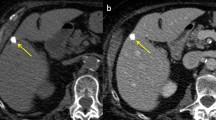Abstract
Purpose
Attenuation imaging (ATI) is a new noninvasive ultrasound technique for assessing steatosis grade (S). However, validated region-of-interest (ROI) sampling strategies are not currently available. We investigated the diagnostic performance of various ATI-ROI positions for determining histopathologic S in patients with nonalcoholic fatty liver disease (NAFLD).
Methods
This retrospective study included 105 patients with biopsy-proven NAFLD. All attenuation coefficient (AC, dB/cm/MHz) measurements were obtained by the same hepatologist using a commercially available ultrasound system on the same day as liver biopsy. Mean (± standard deviation) age and body mass index of the patients were 53 (± 18) years and 27.1 (± 4.1) kg/m2, respectively. The numbers of patients with steatosis affecting < 5%, 5–33%, 33–66%, and > 66% of hepatocytes were 8, 50, 29, and 18, respectively. The ATI-ROI was placed at three different positions for AC measurement using a dedicated workstation: the upper edge of the area ROI, twice the depth of the liver capsule, and the lower edge of the area ROI. Diagnostic performance was evaluated using the area under the receiver-operating characteristic curve (AUC).
Results
The AUCs of AC at the three ATI-ROI positions were 0.734 (95% confidence interval [CI]: 0.470–0.998), 0.750 (0.639–0.861), and 0.878 (0.788–0.968) for S ≥ 1; 0.503 (0.392–0.615), 0.824 (0.741–0.907), and 0.809 (0.724–0.895) for S ≥ 2; and 0.606 (0.486–0.726), 0.849 (0.767–0.932), and 0.737 (0.626–0.848) for S = 3, respectively.
Conclusion
For accurate steatosis grade assessment, the ATI-ROI should not be placed at the upper edge of the area ROI.


Similar content being viewed by others
References
Younossi ZM, Koenig AB, Abdelatif D, et al. Global epidemiology of nonalcoholic fatty liver disease-Meta-analytic assessment of prevalence, incidence, and outcomes. Hepatology. 2016;64:73–84.
VanWagner LB, Rinella ME. Extrahepatic manifestations of nonalcoholic fatty liver disease. Curr Hepatol Rep. 2016;15:75–85.
Sayiner M, Koenig A, Henry L, et al. Epidemiology of nonalcoholic fatty liver disease and nonalcoholic steatohepatitis in the United States and the rest of the world. Clin Liver Dis. 2016;20:205–14.
European Association for the Study of the Liver (EASL); European Association for the Study of Diabetes (EASD); European Association for the Study of Obesity (EASO). EASL-EASD-EASO Clinical Practice Guidelines for the management of non-alcoholic fatty liver disease. J Hepatol. 2016;64:1388–402.
Ajmera V, Park CC, Caussy C, et al. Magnetic resonance imaging proton density fat fraction associates with progression of fibrosis in patients with nonalcoholic fatty liver disease. Gastroenterology. 2018;155:307-10.e2.
Arulanandan A, Ang B, Bettencourt R, et al. Association between quantity of liver fat and cardiovascular risk in patients with nonalcoholic fatty liver disease independent of nonalcoholic steatohepatitis. Clin Gastroenterol Hepatol. 2015;13:1513-520.e1.
Ferraioli G, Soares Monteiro LB. Ultrasound-based techniques for the diagnosis of liver steatosis. World J Gastroenterol. 2019;25:6053–62.
Tada T, Iijima H, Kobayashi N, et al. Usefulness of attenuation imaging with an ultrasound scanner for the evaluation of hepatic steatosis. Ultrasound Med Biol. 2019;45:2679–87.
Ferraioli G, Maiocchi L, Savietto G, et al. Performance of the attenuation imaging technology in the detection of liver steatosis. J Ultrasound Med. 2021;40:1325–32.
Sugimoto K, Moriyasu F, Oshiro H, et al. The role of multiparametric US of the liver for the evaluation of nonalcoholic steatohepatitis. Radiology. 2020;296:532–40.
Bae JS, Lee DH, Lee JY, et al. Assessment of hepatic steatosis by using attenuation imaging: a quantitative, easy-to-perform ultrasound technique. Eur Radiol. 2019;29:6499–507.
Kleiner DE, Brunt EM, Van Natta M, et al. (2005) Nonalcoholic steatohepatitis clinical research network design and validation of a histological scoring system for nonalcoholic fatty liver disease. Hepatology 41:1313–21.
Matteoni CA, Younossi ZM, Gramlich T, et al. Nonalcoholic fatty liver disease: a spectrum of clinical and pathological severity. Gastroenterology. 1999;116:1413–9.
Lee DH, Cho EJ, Bae JS, et al. Accuracy of two-dimensional shear wave elastography and attenuation imaging for evaluation of patients with nonalcoholic steatohepatitis. Clin Gastroenterol Hepatol. 2021;19:797-805.e7.
Jeon SK, Lee JM, Joo I, et al. Prospective evaluation of hepatic steatosis using ultrasound attenuation imaging in patients with chronic liver disease with magnetic resonance imaging proton density fat fraction as the reference Standard. Ultrasound Med Biol. 2019;45:1407–16.
Yoo J, Lee JM, Joo I, et al. Reproducibility of ultrasound attenuation imaging for the noninvasive evaluation of hepatic steatosis. Ultrasonography. 2020;39:121–9.
Author information
Authors and Affiliations
Corresponding author
Ethics declarations
Conflict of interest
All the authors declare no conflicts of interest.
Ethical statement
All the procedures followed were in accordance with the ethical standards of the responsible committee on human experimentation (institutional and national) and with the Helsinki Declaration of 1964 and later versions. This study was approved by the Ethical Review Board of Tokyo Medical University.
Informed consent
Informed consent was waived because this was a retrospective study.
Additional information
Publisher's Note
Springer Nature remains neutral with regard to jurisdictional claims in published maps and institutional affiliations.
About this article
Cite this article
Sugimoto, K., Abe, M., Oshiro, H. et al. The most appropriate region-of-interest position for attenuation coefficient measurement in the evaluation of liver steatosis. J Med Ultrasonics 48, 615–621 (2021). https://doi.org/10.1007/s10396-021-01124-z
Received:
Accepted:
Published:
Issue Date:
DOI: https://doi.org/10.1007/s10396-021-01124-z




